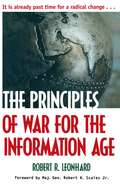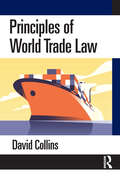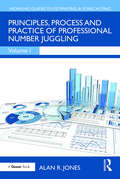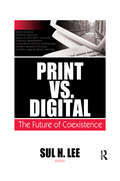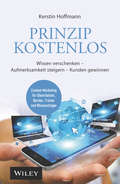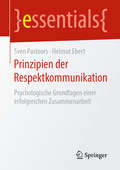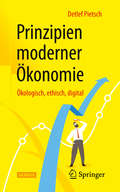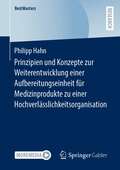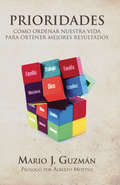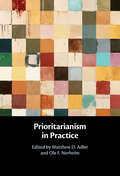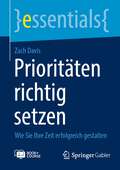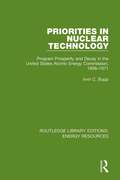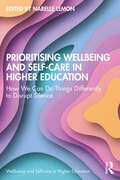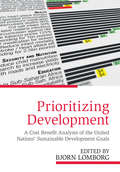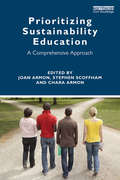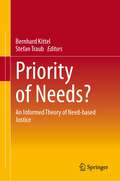- Table View
- List View
The Principles of War for the Information Age
by Robert LeonhardOne of the most cogent and respected strategic theorists in today's military sounds the alarm: We have no viable doctrine for tomorrow's war. The advent of the information age renders the hallowed Principles of War useless. Forged in agrarian times and honed by the more modern conflicts of the industrial age, the principles that have guided generations of America's military leaders have become dangerously outmoded. In this, his latest book, Lt. Col. Robert R. Leonhard, author of the influential Art of Maneuver and Fighting by Minutes, proposes a new set of principles, indeed a new approach to armed conflict.
Principles of Web Design: Understanding The Principles Of Successful Web Site Design
by Brian D. MillerLearn everything there is to know, from project planning through marketing and analytics, about Web design!Principles of Web Design is a book about the fundamentals of clear graphic communication within the context of Web design. Author Brian D. Miller is a sought-after expert in developing product and digital branding strategies for emerging startups and Fortune 500 organizations. In Principles of Web Design, he will teach the reader the tricks of the trade and everything one should know about web design through easy, step-by-step guides and with full-color illustrations. The book has three sections, which follow the cycle of a typical Web project: PLAN: This section focuses on the predesign phase of a Web project. Everything from project planning and brief writing to information architecture and responsive grid creation will be covered.DESIGN: The second section of Priciples of Web Design explores the enduring principles of design and the nuances that are specific to the field of Web design. OPTIMIZE: Finally, we close the loop and discover ways to enable your client to maximize the investment they&’ve made in their Web site with marketing and analytics.
Principles of World-Class Execution: Winning in China
by Jimmy Hexter Jonathan WoetzelFor multinational companies in China, the rapid evolution of markets and competition overwhelmingly demands an exacting focus on world-class execution. This chapter highlights the principles that should guide the efforts MNCs make as they ratchet up their ability to execute in China.
Principles of World Trade Law
by David CollinsPrinciples of World Trade Law presents a comprehensive and balanced picture of the legal framework underpinning the modern world trading system – covering the law of the WTO but also drawing on bilateral and regional instruments. It acknowledges the shifting relevance of the WTO in world trade law in favour of regionalism, particularly in relation to new fields such as digital trade.While drawing heavily on the law of the WTO as a source of legal rules, this concise text also engages with elements found in preferential Free Trade Agreements (FTAs) (such as Rules of Origin) and mutual recognition agreements (such as recognition of professional qualifications in the case of services). Practical in nature, it blends straightforward descriptive explanations of the legal concepts with critical inquiry, directing readers to the key debates in the field as well as the source materials themselves. It also offers guidance with discussion questions for the reader to consider for each chapter.Principles of World Trade Law is an ideal introductory textbook for advanced undergraduate and postgraduate students taking courses in world trade law, international trade law, and international economic law as well as a valuable guide for scholars, legal practitioners and policymakers.
Principles & Practices of New Jersey Real Estate (19th Edition)
by Frank W. Frank W. KovatsThe economic importance of real estate today demands a higher professional level for all persons dealing in real estate, with an increased emphasis on educational requirements. Also, every state requires that a person engaging professionally in the real estate business, either as a broker or as a salesperson, must be licensed, and in each case, a state examination is a prerequisite for a license. Principles and Practices of New Jersey Real Estate has been written to serve as an educational guide for students and for persons desiring to take New Jersey's real estate licensing examination, as a quick reference for those already in the profession, and for use by the many other professionals dealing with various aspects of real estate.
Principles, Process and Practice of Professional Number Juggling (Working Guides to Estimating & Forecasting)
by null Alan JonesPrinciples, Process and Practice of Professional Number Juggling (Volume 1 of the Working Guides to Estimating & Forecasting series) sets the scene of TRACEability and good estimate practice that is followed in the other volumes in this series of five working guides. It clarifies the difference between an Estimating Process, Procedure, Approach, Method and Technique. It expands on these definitions of Approach (Top-down, Bottom-up and‘Ethereal’) and Method (Analogy, Parametric and ‘Trusted Source’) and discusses how these form the basis of all other means of establishing an estimate.This volume also underlines the importance of ‘data normalisation’ in any estimating procedure, and demonstrates that the Estimating by Analogy Method, in essence, is a simple extension of Data Normalisation. The author looks at simple measures of assessing the maturity or health of an estimate, and offers a means of assessing a spreadsheet for any inherent risks or errors that may be introduced by failing to follow good practice in spreadsheet design and build.This book provides a taster of the more numerical techniques covered in the remainder of the series by considering how an estimator can potentially exploit Benford’s Law (traditionally used in Fraud Detection) to identify systematic bias from third party contributors. It will be a valuable resource for estimators, engineers, accountants, project risk specialists as well as students of cost engineering.
Print Production: A Complete Guide to Planning, Printing and Packaging
by Margherita MarianoThe result of 35 years of experience in the publishing and printing industry, this bible provides all the information needed by anyone who wants to print and produce any type of document whether a book, a magazine, a poster or a brochure.Graphic designers, editors, production controllers, and those working in communications and marketing will find all they need to know and understand in this must-have book that clearly and authoritatively presents the theoretical facts and the technical information, but also deals with the human know-how. Richly illustrated and produced to a very high spec, this key companion covers the whole process of production step-by-step, from initial concept to the achievement of a printed object. It provides many practical tips, alerts on the traps to avoid and answers those tricky questions that you may be afraid to ask.
Print Production: A Complete Guide to Planning, Printing and Packaging
by Margherita MarianoThe result of 35 years of experience in the publishing and printing industry, this bible provides all the information needed by anyone who wants to print and produce any type of document whether a book, a magazine, a poster or a brochure.Graphic designers, editors, production controllers, and those working in communications and marketing will find all they need to know and understand in this must-have book that clearly and authoritatively presents the theoretical facts and the technical information, but also deals with the human know-how. Richly illustrated and produced to a very high spec, this key companion covers the whole process of production step-by-step, from initial concept to the achievement of a printed object. It provides many practical tips, alerts on the traps to avoid and answers those tricky questions that you may be afraid to ask.
Print vs. Digital: The Future of Coexistence (Monographs From The Journal Of Library Administration Ser.)
by Sul H. LeeLibraries are currently confronted by the challenges of managing increasing amounts of electronic information. Print vs. Digital: The Future of Coexistence presents the expert perspectives of eight of America’s leading library administrators on ways to effectively manage digital flow and offers strategies to provide a level of coexistence between digital and print information. This excellent overview explores how to best balance print and electronic resources, and explores important issues such as the selection of electronic resources, improving access to digital information for a larger user base, and effective management of a library’s fiscal and personnel resources. Print vs. Digital: The Future of Coexistence discusses the various challenges libraries now face from the massive influx of digital resources, including the ways that information-seeking behaviors have changed, the search for synergies between print and digital, economics of news preservation, and whether or not the end of print journals is at hand. New ideas and technological advances are explored, including the diverse ways these improvements will impact the future. This well-referenced resource includes useful tables, figures, and photographs. Topics in Print vs. Digital: The Future of Coexistence include: cooperative collection development balance of print and electronic resources evolvement of digital resources in libraries change in research libraries factors influencing the selection of electronic resources disseminating information about scholarly collections impact of digital resources on research behavior and techniques design of digital libraries JSTOR effects of digital information on reference collections transition of print journals to digital formats Print vs. Digital: The Future of Coexistence is a thought provoking, insightful resource on the future of libraries, invaluable for acquisitions, reference, and collection development librarians; and senior and mid-level administrators such as deans, directors, and department heads for public, special, and academic libraries.
Prinzip kostenlos: Wissen verschenken - Aufmerksamkeit steigern - Kunden gewinnen
by Kerstin HoffmannSie sind Berater, Trainer, Speaker oder Experte in einem Spezialgebiet? Sie leiten ein Unternehmen im Dienstleistungsbereich oder sind für dessen Marketing verantwortlich? Sie brauchen neue Aufträge? Sie möchten Ihren Marktwert steigern? Dann verschenken Sie doch einfach Ihr Wissen! Das funktioniert für größere Unternehmen genauso wie für Freiberufler. Entscheidend ist nur die Tatsache, dass Sie auf einem Gebiet mehr wissen als andere. Die Kommunikationsexpertin Dr. Kerstin Hoffmann zeigt, wie Sie mit dem "Prinzip kostenlos" zu mehr Bekanntheit und zu neuen Kunden gelangen - vor allem im Internet, aber auch über klassische Wege. Das Buch führt Sie durch die gesamte Strategie des verschenkten Wissens: Wie lässt sich Wissen geschenkfertig portionieren? Welche sind die richtigen Verbreitungsplattformen im Netz? Wie bauen Sie Ihre Strategie auf? Wie setzen Sie sie technisch um? Wie wandeln Sie die Aufmerksamkeit Ihrer Leser in gut bezahlte Aufträge um? "Prinzip kostenlos" bietet Ihnen das nötige Handwerkszeug, um Ihre eigene Strategie von Grund auf zu entwickeln und zum dauerhaften Erfolg zu führen. Bekannte "Wissens-Teiler" berichten in Interviews von ihren Erfahrungen. Checklisten und einige bislang unveröffentlichte Kniffe ergänzen den praxisnahen Ratgeber. Die 2. Auflage greift Änderungen und aktuelle technische Trends auf. So spielt z. B. Google+ als Plattform keine große Rolle mehr, dafür Instagram und Snapchat. Außerdem wird das Kapitel über Blogs umgeschrieben und angepasst.
Prinzipien der Respektkommunikation: Psychologische Grundlagen einer erfolgreichen Zusammenarbeit (essentials)
by Sven Pastoors Helmut EbertDieses essential erläutert anhand praxisorientierter Beispiele die Prinzipien der Respektkommunikation. Es konzentriert sich dabei auf die vier Bereiche Selbstrespekt, Kommunikation, Integration und Mitarbeiterführung. Diese Prinzipien helfen den Lesern, ihre Ziele souverän und respektvoll zu erreichen. Gleichzeitig können sie mit diesen Prinzipien verhindern, dass die eigene Verwirklichung auf Kosten anderer erfolgt und so zu immer kurzfristigeren Erfolgen in den genannten Bereichen führt.
Prinzipien moderner Ökonomie: Ökologisch, ethisch, digital
by Detlef PietschDie moderne Ökonomie befindet sich in einem tiefgreifenden Wandel. Während schon seit geraumer Zeit der Kapitalismus als Wirtschaftsform massiver Kritik ausgesetzt ist, stellen sich, ausgelöst durch die jüngsten Ereignisse rund um die Corona-Pandemie, weitere grundlegende Fragen an die Ökonomie: Wie viel Staat und wie viel Markt braucht sie? Hält die moderne Ökonomie für die Ökologie die richtigen Antworten bereit? Hat sie ein Rezept für die zunehmende Ungleichheit in unserer Gesellschaft und wie sieht es zukünftig mit unserem Wohlstand aus? Ist die heutige Ökonomie auf die Auswirkungen der Digitalisierung ausreichend vorbereitet und welchen Beitrag liefert die ökonomische Theorie zu allen diesen Themen? Das sind die wichtigsten Fragen, die dieses Buch beantworten will. Gerade die dramatische Krise des Jahres 2020 hat gezeigt, dass die Wirtschaft mit ihren Akteuren und Unternehmen ohne den Staat nicht alleine existieren kann. Gigantische staatliche Rettungsschirme in dreistelliger Milliardenhöhe von EU, Bund und Ländern haben wesentliche Teile der Wirtschaft vor dem sicheren Ruin bewahrt. Es scheint, dass wir wesentliche Grundfragen unserer modernen Wirtschaft neu hinterfragen müssen. Nachdem Detlef Pietsch in seinem letzten Buch “Eine Reise durch die Ökonomie“ vor allem die ökonomische Vergangenheit und ihre Kernideen erläutert hat, widmet er sich nun der Gegenwart. Spannend zu lesen, lehrreich und regt zum Nachdenken über die heutige Ökonomie an.
Prinzipien und Konzepte zur Weiterentwicklung einer Aufbereitungseinheit für Medizinprodukte zu einer Hochverlässlichkeitsorganisation (BestMasters)
by Philipp HahnWiederaufbereitung gebrauchter Medizinprodukte (MP) dient dazu, MP nach operativen Eingriffen zu reinigen, zu desinfizieren, zu überprüfen, zu packen und zu sterilisieren. Sachgerechte und rechtskonforme Wiederaufbereitung von MPs in einer Aufbereitungseinheit für MP (AEMP) zwecks Verwendung am Patienten ist eine komplexe Dienstleistung mit höchsten Anforderungen an Verlässlichkeit in den Qualitätszielen Sauberkeit, Sterilität, Funktionsfähigkeit, Vollständigkeit und Pünktlichkeit der ausgelieferten Produkte. Das neue vorgelegte Konzept geht davon aus, dass eine AEMP wegen ihrer Bedeutung für die Abläufe eines Klinikums und wegen der Komplexität der Anforderungen als Hochverlässlichkeitsorganisation (HRO) zu betrachten ist. HROs gelingt es, komplexe und technologieintensive Verfahren mit sehr geringer Fehlerrate und nahezu Ausbleiben von katastrophalem Versagen einzusetzen. Die anhand von HROs gewonnenen Erkenntnisse nutzt der Autor für sein Konzept, um Herausforderungen beim Betrieb einer AEMP mit solchen Verfahren anzugehen, die bei HROs erprobt sind und dort erfolgreich gehandhabt werden. Daraus wird ein Konzept zur Weiterentwicklung einer AEMP in Richtung einer HRO entwickelt und vorgestellt.
Prioridades: Cómo ordenar nuestra vida para obtener mejores resultados
by Mario J. GuzmánPrincipios que transforman su relación con Dios, vida familiar y ministerio Existen grandes soñadores que no han podido ver sus sueños realizados por el desequilibrio y la indiscipllina que hubo en sus vidas. Otros han logrado sus sueños, pero en el camino LA FAMILIA se ha debilitado y desintegrado. Muchos hijos de personas exitosas no han tenido un desarrollo saludable. Podemos alcanzar éxito, pero: ¿Quién se está llevando lo mejor de nosotros? Procuremos que nuestra familia o nuestra intimidad con Dios no sea el precio de nuestro éxito. Conozca la importancia de ordenar su vida y de establecer prioridades. El pastor Mario J. Guzmán presenta de una forma clara y práctica principios bíblicos que le ayudarán a: -Tener una relación madura con Dios - Tener un noviazgo bien enfocado - Tener un matrimonio e hijos saludables - Desarrollarse en el ministerio eficazmente - Elevar su área laboral a la excelencia - Ser de voluntad firme - Terminar las cosas que ha comenzado
Prioridades na negociação de adesão da Roménia à UE: Integração europeia
by Perju GenovevaA competitividade das exportações romenas melhorou tanto como resultado da reestruturação da economia como da desvalorização da moeda. O exemplo da produção industrial é ilustrativo. A produção da indústria de processamento diminuiu com 8% em 1999 face a 1998, a sua participação em exportações aumentando de 30,7% a 35,1%, e a taxa de crescimento das exportações foi de 5,9%. O efeito principal foi uma redução do défice da conta corrente. Em geral, o défice da conta corrente flutuou, representando, em média, 5,2% de PIB. O défice orçamentário foi difícil de controlar, mas conseguiu-se através da aplicação dos rigores da União Européia. Podemos falar sobre desempenhos também em termos do nível da dívida externa em relação ao nível da dívida externa da União, que se situa em um nível mais elevado em comparação com o de outros países candidatos. O mercado de trabalho foi afetado por desequilíbrios, tanto no nível da relação entre a população ativa e a inativa, quanto na taxa de emprego. A população ocupada na agricultura detêm aproximadamente 40% do total da população ocupada. Além disso, uma grande parte da população foi afectada pela pobreza (aproximadamente 33,8%), em especial a população do meio rural (40,5%). Num tal quadro interno e internacional, marcado por interdependências com ecos em plano interno da União ou dos países candidatos, a resolução de situações divergentes ou a eliminação dos obstáculos no caminho de assumir certas obrigações e execícios da vontade política, a qualidade e a experiência do negociador podem ser consideradas decisivas para a continuação da cooperação.
Prioritarianism in Practice
by Matthew D. Adler Ole F. NorheimPrioritarianism is an ethical theory that gives extra weight to the well-being of the worse off. In contrast, dominant policy-evaluation methodologies, such as benefit-cost analysis, cost-effectiveness analysis, and utilitarianism, ignore or downplay issues of fair distribution. Based on a research group founded by the editors, this important book is the first to show how prioritarianism can be used to assess governmental policies and evaluate societal conditions. This book uses prioritarianism as a methodology to evaluate governmental policy across a variety of policy domains: taxation, health policy, risk regulation, education, climate policy, and the COVID-19 pandemic. It is also the first to demonstrate how prioritarianism improves on GDP as an indicator of a society's progress over time. Edited by two senior figures in the field with contributions from some of the world's leading economists, this volume bridges the gap from the theory of prioritarianism to its practical application.
Prioritäten richtig setzen: Wie Sie Ihre Zeit erfolgreich gestalten (essentials)
by Zach DavisWenn Sie (zu) viel zu tun und zu wenig Zeit haben, Ihr Alltag von Unterbrechungen, Unvorhersehbarem und hohen Anforderungen gekennzeichnet ist, werden Sie hier fündig. Sie erfahren, wie Sie die Fremdsteuerung in den Griff bekommen und durch ein verbessertes Selbst- und Zeitmanagement Ihre Produktivität steigern und den Stresspegel senken.Dieses Werk zeichnet sich durch seine Praxistauglichkeit aus – es ist von einem Praktiker für Praktiker entwickelt. Sie erhalten die Skills, die Sie für eine zunehmend herausfordernde Welt benötigen.Den kostenlosen Zugang zum Online-Kurs finden Sie direkt im Buch.
Priorités dans la négociation de l'adhésion de la Roumanie à l'Union européenne: intégration européenne
by Perju GenovevaPriorités dans la négociation de l'adhésion de la Roumanie à l'Union européenne par le Prof. ec. Dr Perju Genoveva-Elena intégration européenne La compétitivité des exportations roumaines s'est améliorée à la fois du fait de la restructuration de l'économie et de la dévaluation de la monnaie. L'exemple de la production industrielle est illustratif. La production de l'industrie manufacturière a diminué de 8% en 1999 par rapport à 1998, sa part dans les exportations est passée de 30,7% à 35,1% et le taux de croissance des exportations a été de 5,9%. Le principal effet a été une réduction du déficit de la balance courante. En général, le déficit du compte courant a fluctué, représentant en moyenne 5,2% du PIB. Le déficit budgétaire était difficile à contrôler mais a été atteint en appliquant les rigueurs de l'Union européenne. On peut également parler de performance en termes de niveau de dette extérieure par rapport au niveau de dette extérieure de l'Union qui est à un niveau plus élevé que les autres pays candidats. Le marché du travail a été affecté par des déséquilibres tant dans le rapport entre la population active et inactive que dans le taux d'emploi. La population employée dans l'agriculture possède environ 40% de la population employée totale. En outre, une grande partie de la population était touchée par la pauvreté (environ 33,8%), en particulier la population rurale (40,5%). Dans un tel cadre interne et international marqué par des interdépendances qui se répercutent en interne dans l'Union ou les pays candidats, résolvant des situations divergentes ou supprimant les obstacles à la prise d'obligations et une volonté politique stimulante, la qualité et l'expérience du négociateur peuvent être considérées comme déterminantes pour la poursuite de la coopération.
Priorities in negotiating Romania's accession to the European Union: European integration
by Perju GenovevaPriorities in negotiating Romania's accession to the European Union by Prof. ec. Dr. Genoveva-Elena period Priorities in negotiating Romania's accession to the European Union The competitiveness of the Romanian exports has improved both as a result of the restructuring of the economy and the devaluation of the currency. The example of industrial production is illustrative. Production of the processing industry decreased by 8% in 1999 compared to 1998, its share in exports increasing from 30.7% to 35.1% and the export growth rate was 5.9%. The main effect was a reduction of the current account deficit. Overall, the current account deficit fluctuated, representing on average 5.2% of GDP. The budget deficit was difficult to control but it was achieved by applying the European Union's strictures. We can also talk about performance in terms of the level of external debt relative to the level of the external debt of the Union, which is at a higher level than other candidate countries. The labor market was affected by imbalances both in the ratio of the active and inactive population and in the employment rate. The population employed in agriculture owns about 40% of the total employed population. In addition, a large part of the population was affected by the poor (approximately 33.8%) population, especially in rural areas (40.5%). In such an internal and international framework marked by interdependencies with echoes internally from the Union or candidate countries, resolving divergent situations or removing obstacles to assuming obligations and arousing political will, the quality and experience of the negotiator can be considered decisive for further cooperation.
Priorities in Nuclear Technology: Program Prosperity and Decay in the United States Atomic Energy Commission, 1956-1971 (Routledge Library Editions: Energy Resources)
by Irvin C. BuppOriginally published in 1988. This book considers why some public policies succeed and others do not. It looks at the entrepreneurial process that creates public policies and examines whether they prosper or falter because of their political consequences. The programs and personnel of the Atomic Energy Commission are the empirical foundation for these arguments. The data generated by that agency's annual budget-making cycles, collected over time and organised by program, are used as evidence to test some propositions about policy formation within the executive branch of government. The author's concern is with questions of where and how priorities are established in a complex institutional environment. To answer the more fundamental causal question of why some programs prosper while others wither or die, use is made of more historical analysis and comparison of the fortunes of several of AEC's efforts to develop applied nuclear technology.
Prioritising Wellbeing and Self-Care in Higher Education: How We Can Do Things Differently to Disrupt Silence (Wellbeing and Self-care in Higher Education)
by Narelle LemonThis book illuminates international voices of those who feel empowered to do things differently in higher education, providing inspiration to those who are seeking guidance, reassurance, or a beacon of hope.Doing things differently comes with an awareness and curiosity to explore what can be. Increasingly, more and more professionals in higher education are choosing themselves, happiness, families, relationships, kindness, and compassion over arbitrary notions of institutional prestige, continuous pressure to overwork, and competitiveness with others. The chapters in this book do more than highlight flaws in the system, they call for proactive engagement in interrupting and reimagining what is broken. The authors share their own experiences as a way of encouraging readers to take small steps towards self-care, to notice their surroundings, and to embrace change as an empowering tool. The focus is on becoming the change we aspire to see, with a collective readiness to instigate positive transformations.Sharing ambitious ideas to encourage change, this book is a valuable resource for those seeking to enhance their self-care and wellbeing in the higher education context, and for those seeking to engage with others in support of these efforts.
Prioritize Brands in the Portfolio: Developing a Brand Portfolio Strategy in a Silo Environment
by David AakerMost CMOs looking at their organizations see too many brands with too few priorities and too little leverage-a context that makes it difficult to create strong brands and effective marketing. Silos, particularly product silos, can significantly contribute to brand proliferation and the absence of an effective portfolio strategy. Developing a brand portfolio strategy in a silo environment involves making the decision to add or eliminate brands, assign roles and establish priorities, and determine how to leverage the strategic brands. This chapter introduces three frameworks that can help.
Prioritizing Development: A Cost Benefit Analysis of the United Nations' Sustainable Development Goals
by Bjorn LomborgThis book is a unique guide to making the world a better place. Experts apply a critical eye to the United Nations' Sustainable Development agenda, also known as the Global Goals, which will affect the flow of $2.5 trillion of development aid up until 2030. Renowned economists, led by Bjorn Lomborg, determine what pursuing different targets will cost and achieve in social, environmental and economic benefits. There are 169 targets, covering every area of international development – from health to education, sanitation to conflict. Together, these analyses make the case for prioritizing the most effective development investments. A panel of Nobel Laureate economists identify a set of 19 phenomenal development targets, and argue that this would achieve as much as quadrupling the global aid budget.
Prioritizing Sustainability Education: A Comprehensive Approach
by Joan Armon Stephen Scoffham Chara ArmonPrioritizing Sustainability Education presents theory-to-practice essays and case studies by educators from six countries who elucidate dynamic approaches to sustainability education. Too often, students graduate with exploitative, consumer-driven orientations toward ecosystems and are unprepared to confront the urgent challenges presented by environmental degradation. Educators are prioritizing sustainability-oriented courses and programs that cultivate students’ knowledge, skills, and values and contextualize them within relational connections to local and global ecosystems. Little has yet been written, however, about the comprehensive sustainability education that educators are currently designing and implementing, often across or at the edges of disciplinary boundaries. The approaches described in this book expand beyond conventional emphases on developing students’ attitudes, knowledge, and behaviors by thinking and talking about ecosystems to additionally engaging students with ecosystems in sensory, affective, psychological, and cognitive dimensions, as well as imaginative, spiritual, or existential dimensions that guide environmental care and regeneration. This book supports educators and graduate and upper-level undergraduate students in the humanities, social sciences, environmental studies, environmental sciences, and professional programs in considering how to reorient their fields toward relational sustainability perspectives and practices.
Priority of Needs?: An Informed Theory of Need-based Justice
by Bernhard Kittel Stefan TraubThis book develops an empirically informed normative theory of need-based justice, summarizing core findings of the DFG research group FOR2104 “Need-based Justice and Distributive Procedures”. In eleven chapters scholars from the fields of economics, political science, philosophy, psychology, and sociology cover the identification and rationale of needs, the recognition and legitimacy of needs, the dynamics and stability of procedures of distributions according to needs, and the consequences and sustainability of need-based distributions. These four areas are studied from the perspective of two mechanisms of need objectification, the social objectification by the discursive generation of mutual understanding (transparency) and the factual objectification by the transfer of decisions to uninvolved experts (expertise). The volume addresses academics in the fields of justice research, ethics, political theory, social choice and welfare, framing, individual and group decision making, inequality and redistribution, as well as advanced students in the contributing disciplines.
